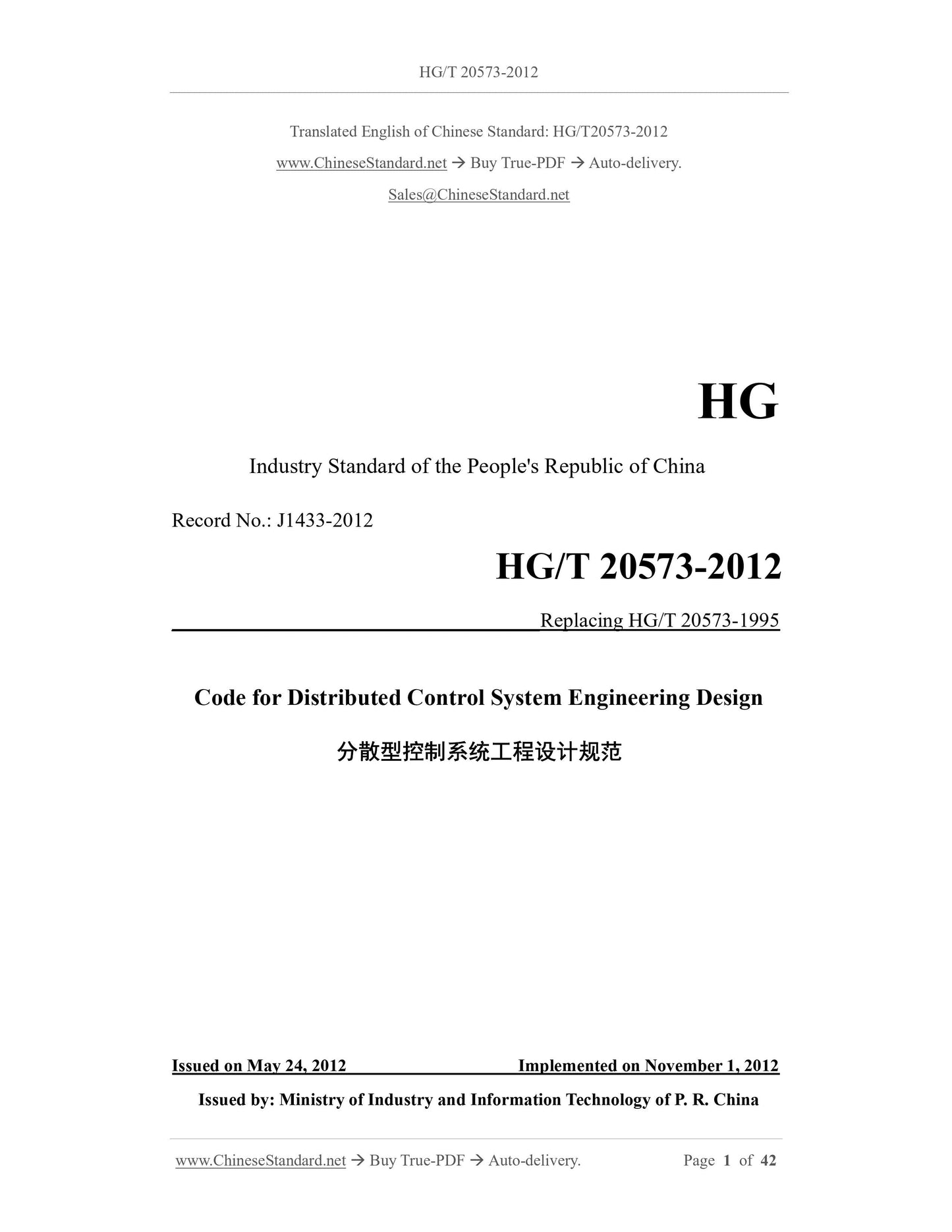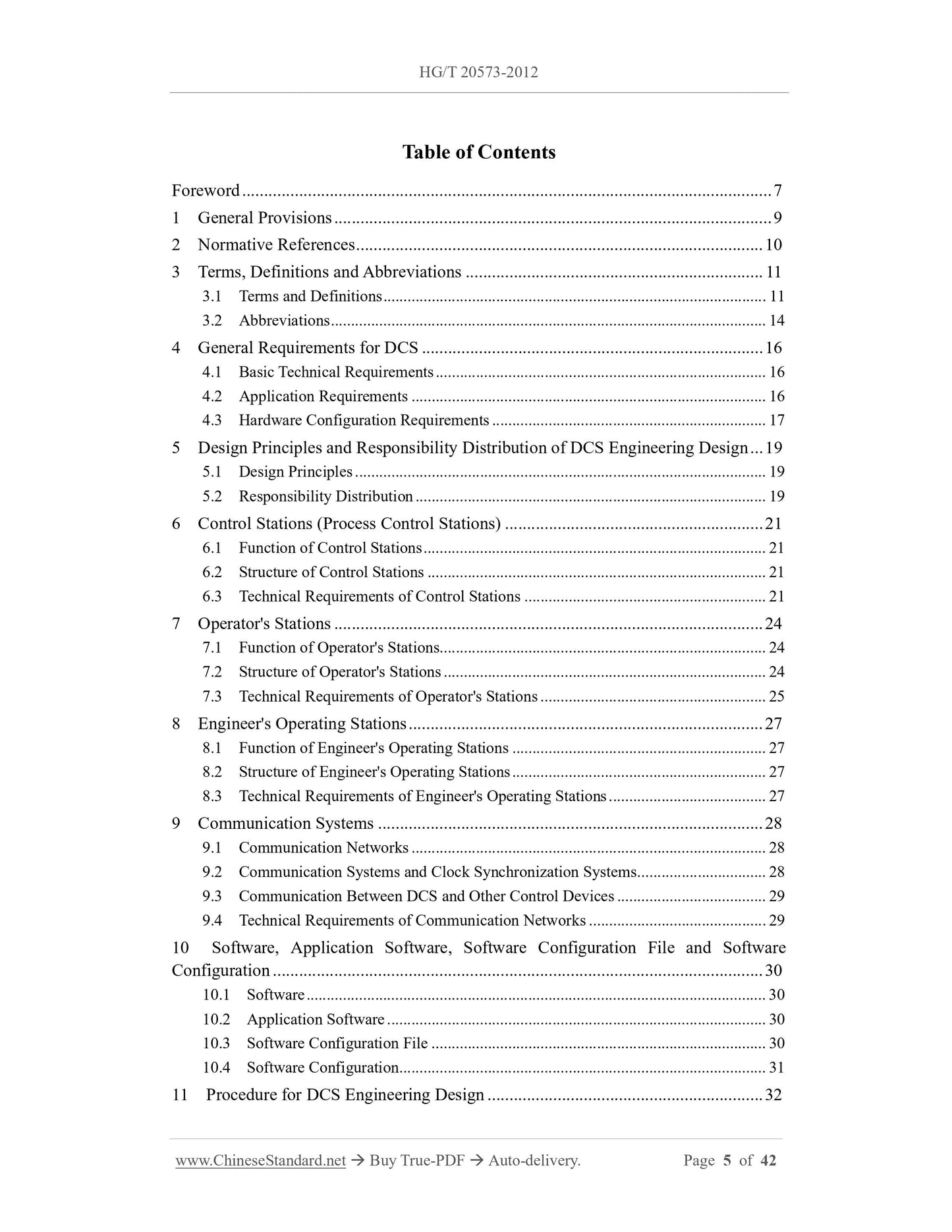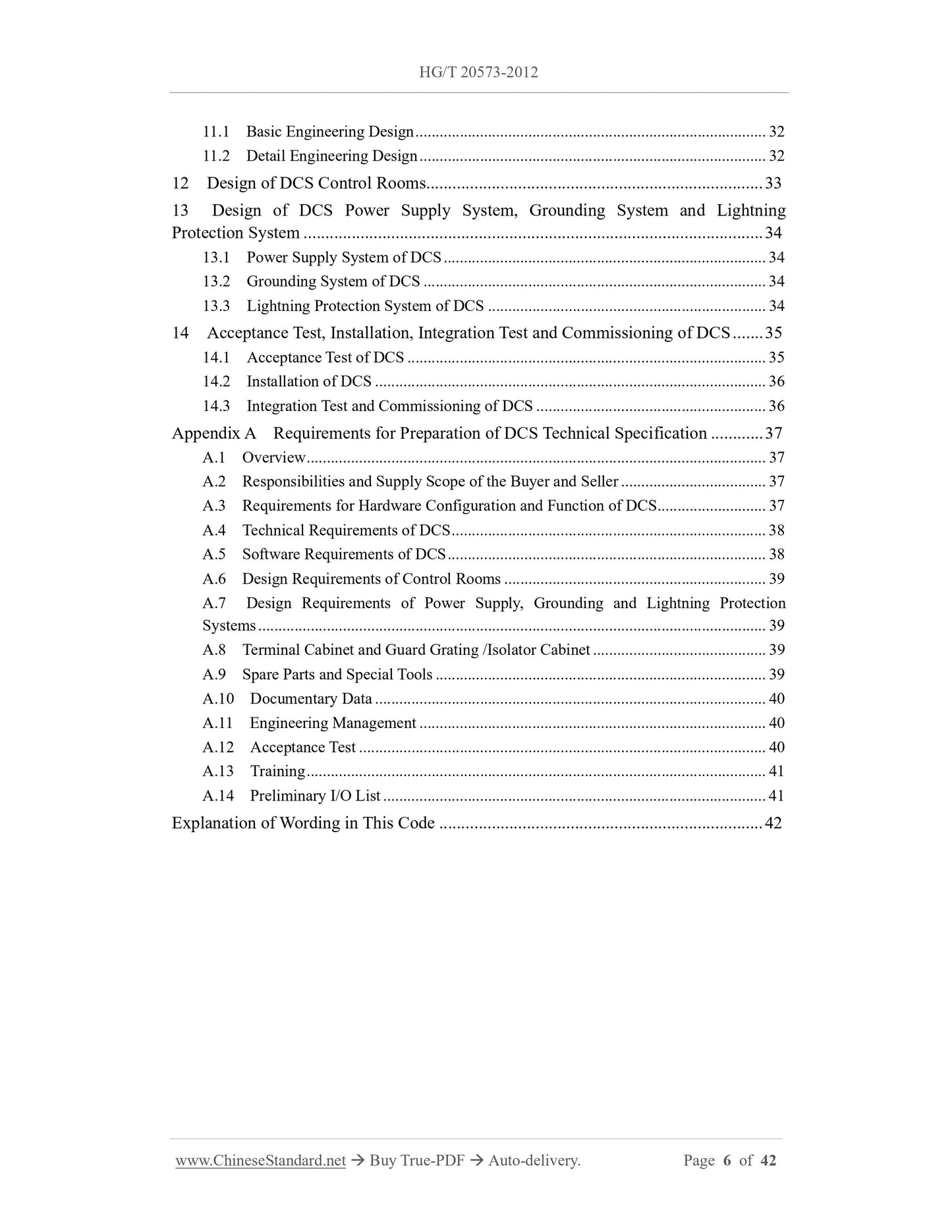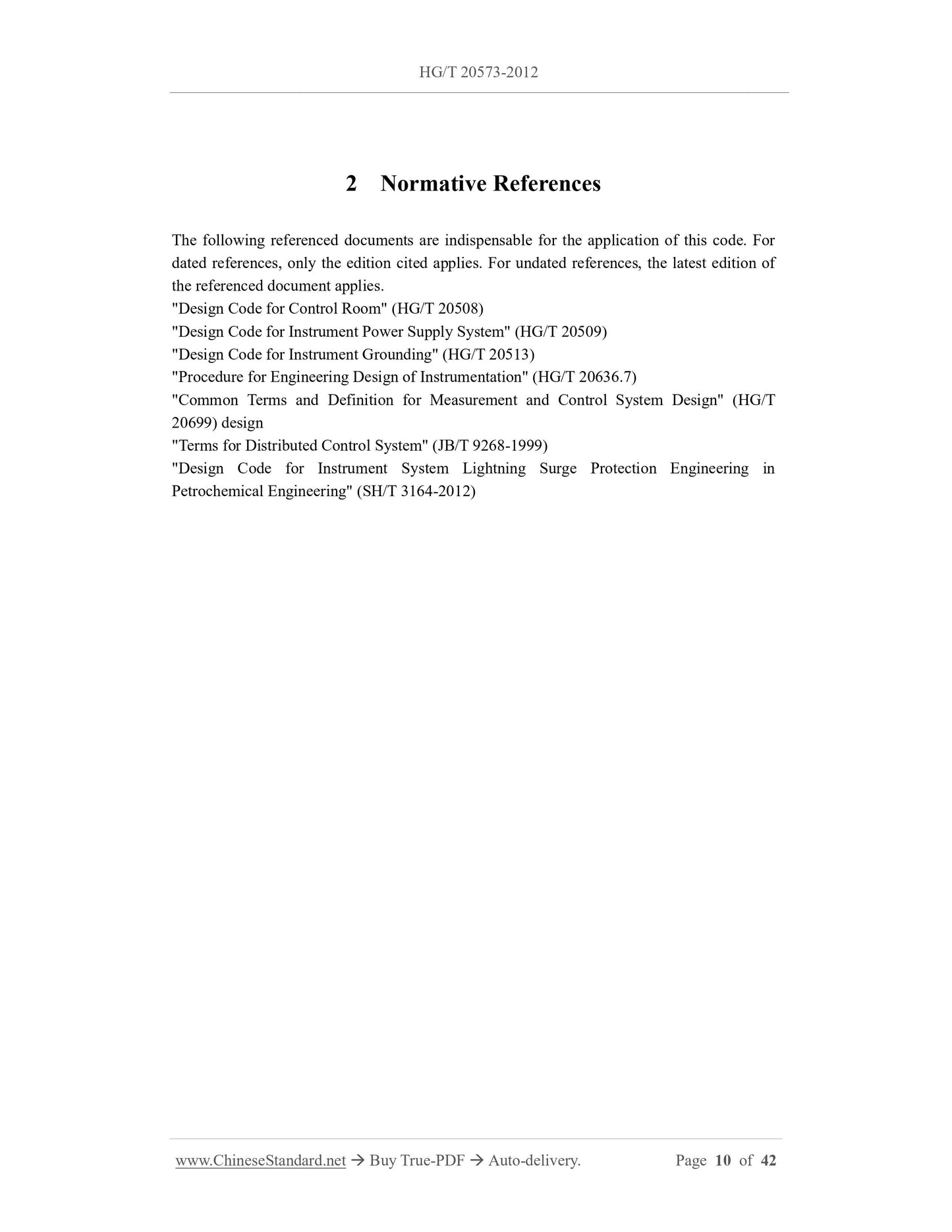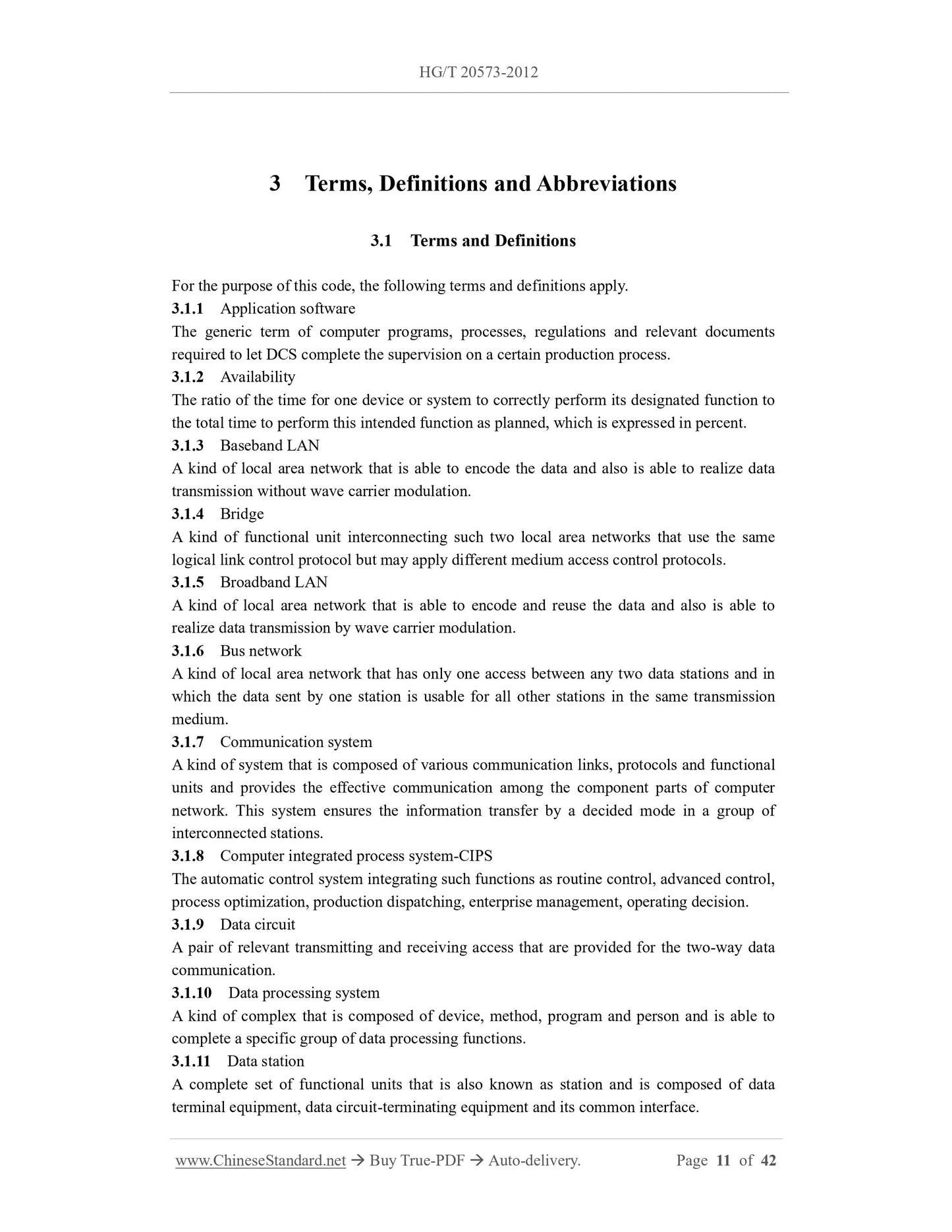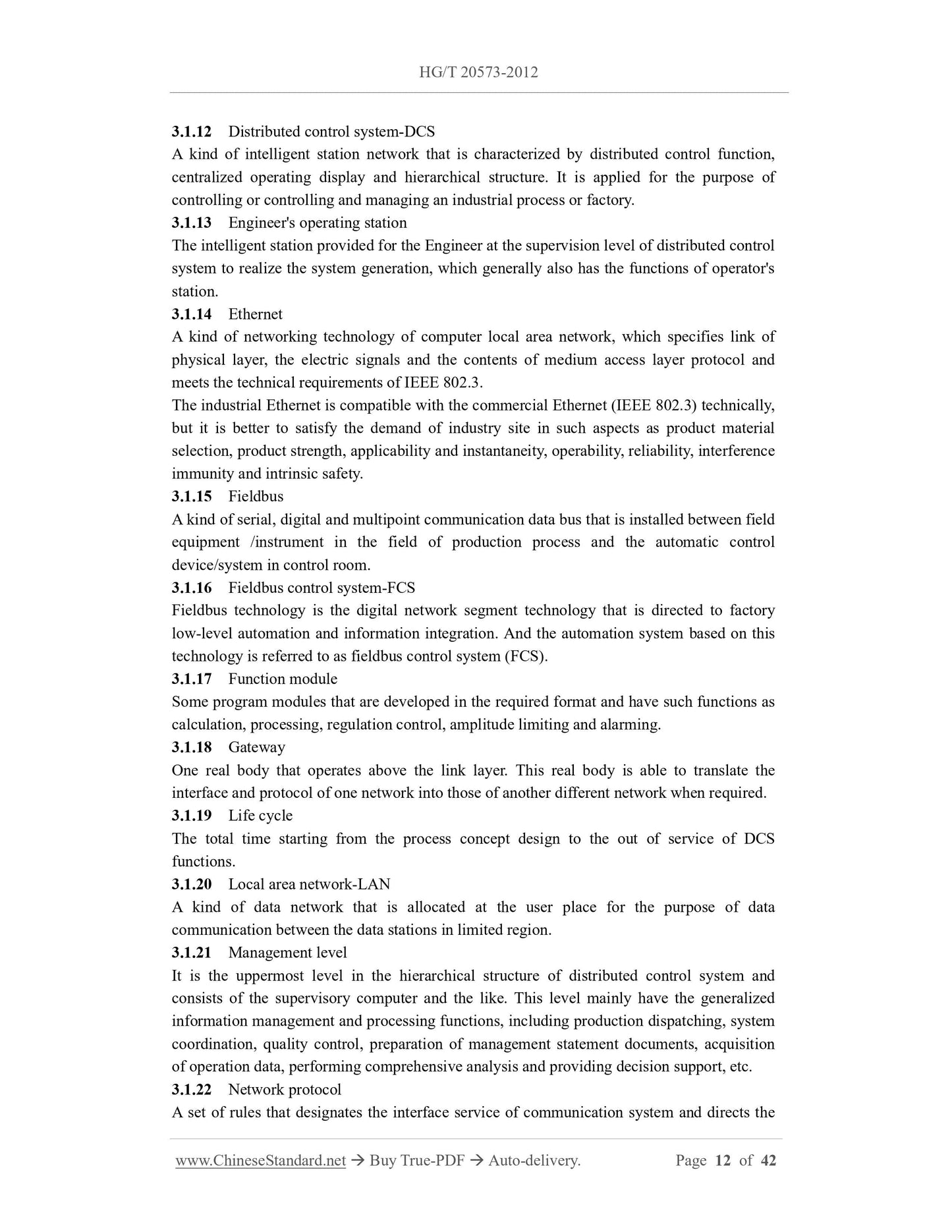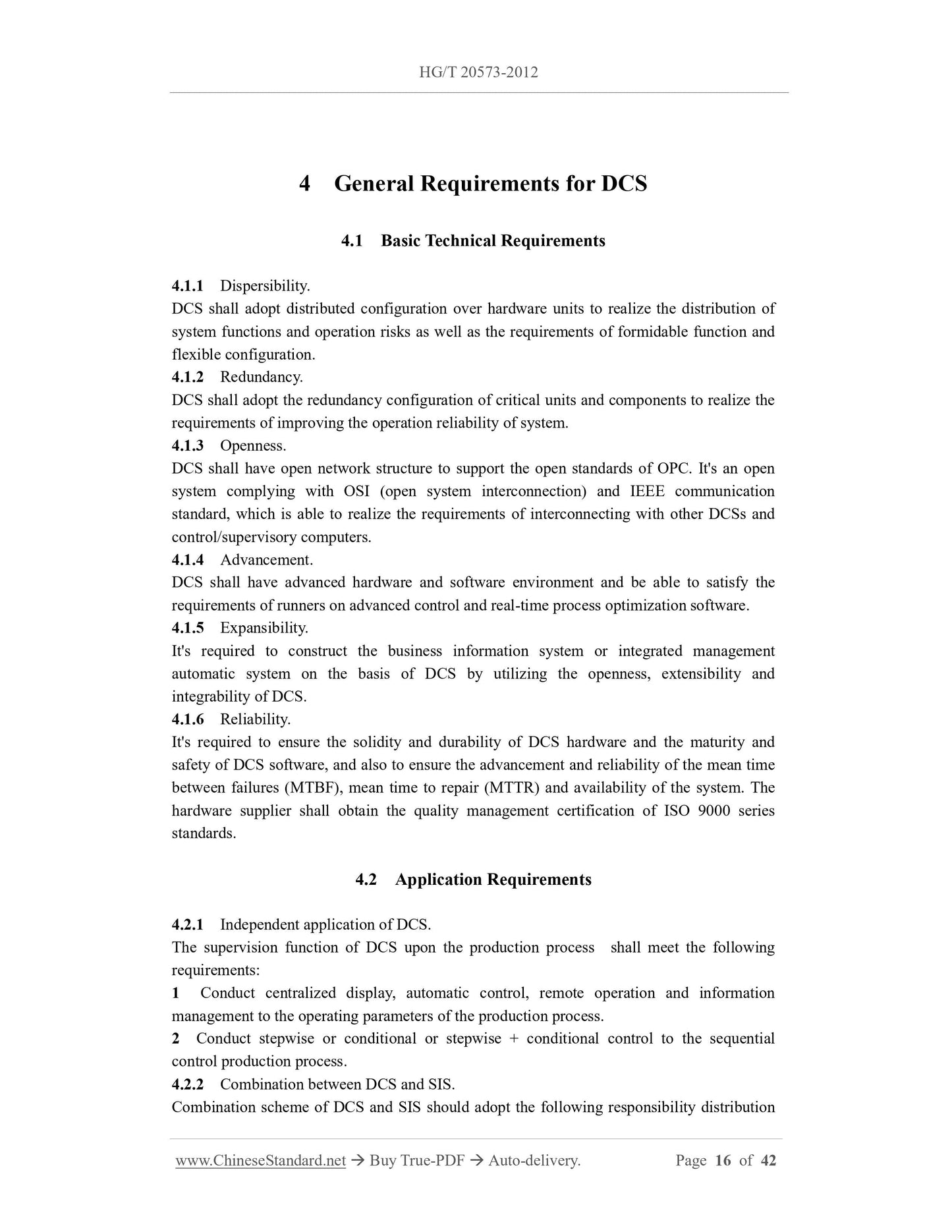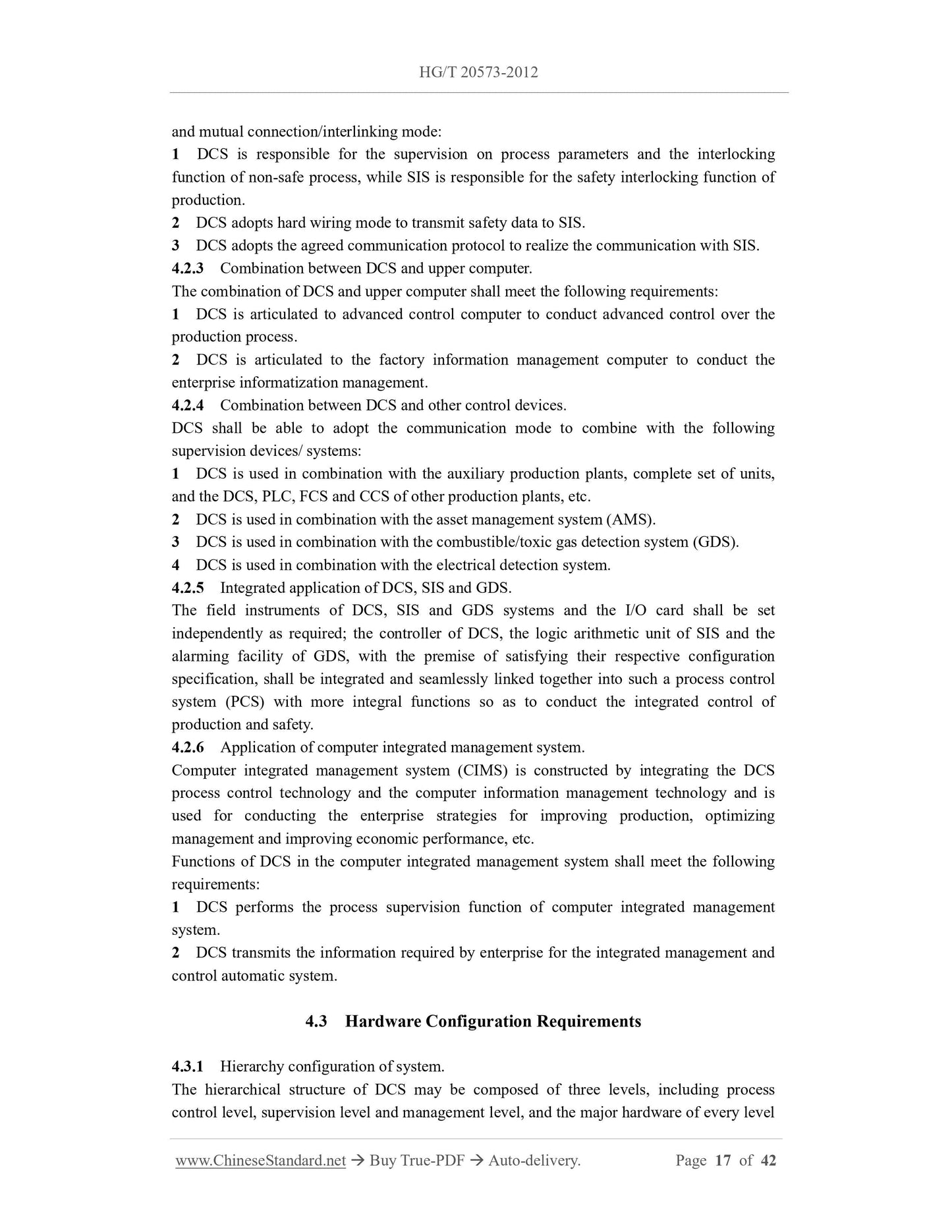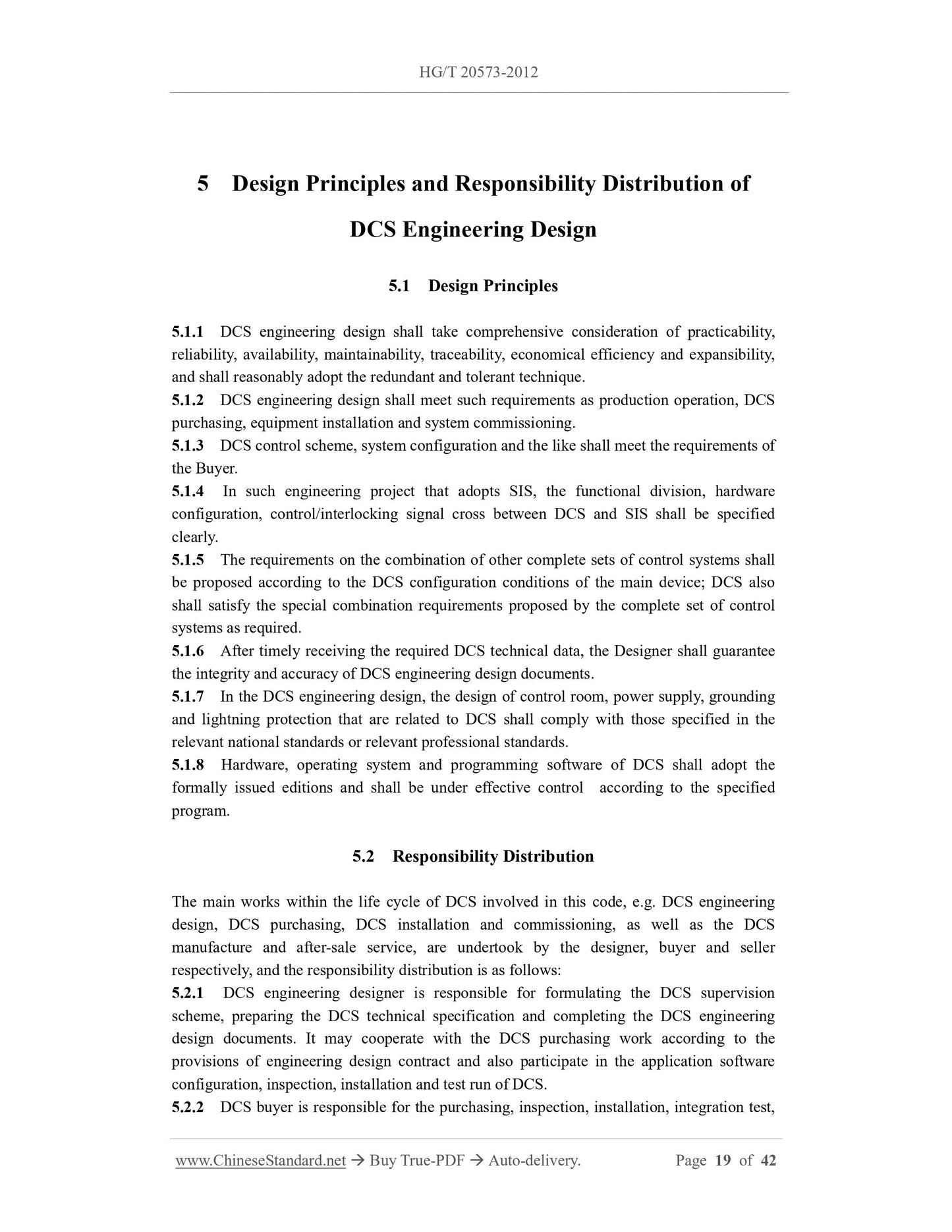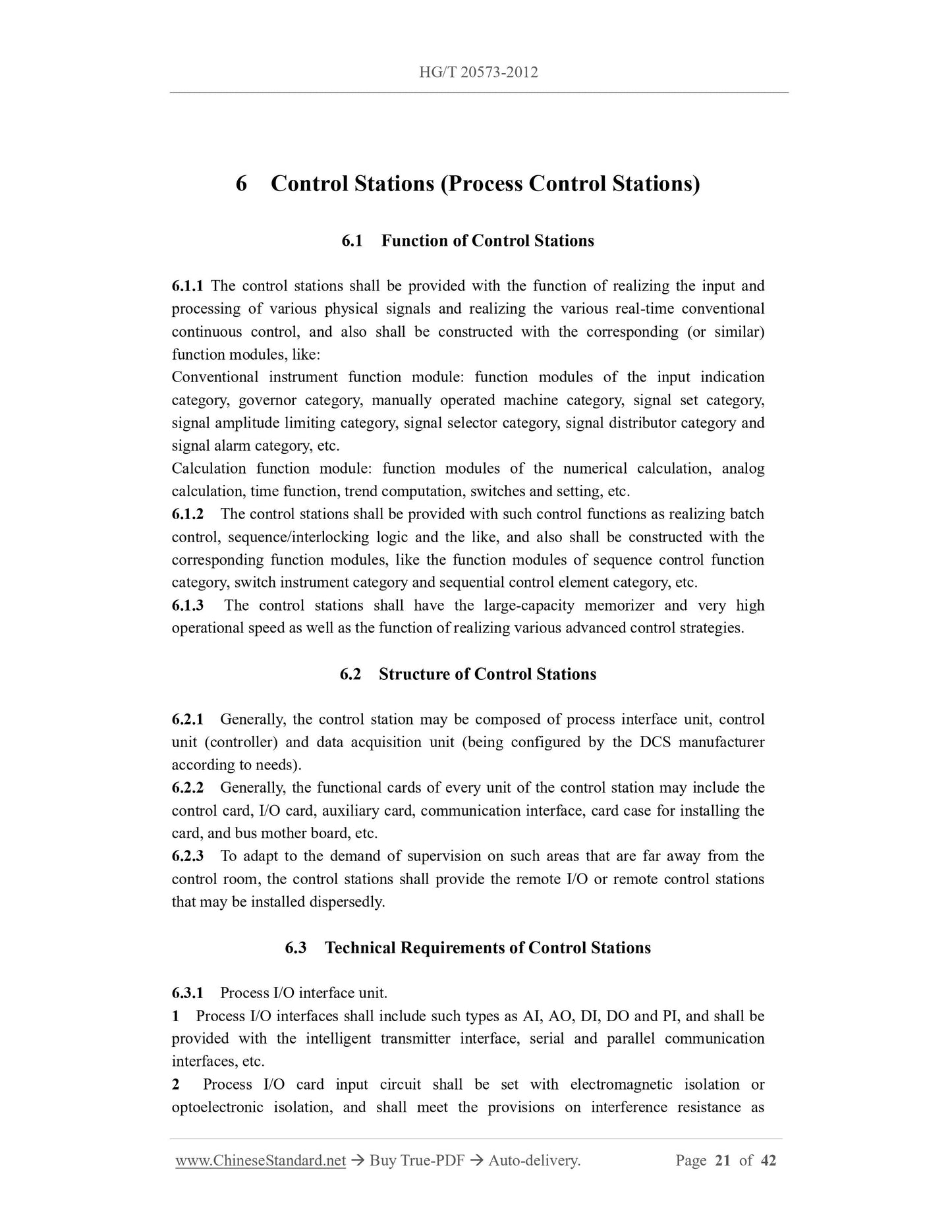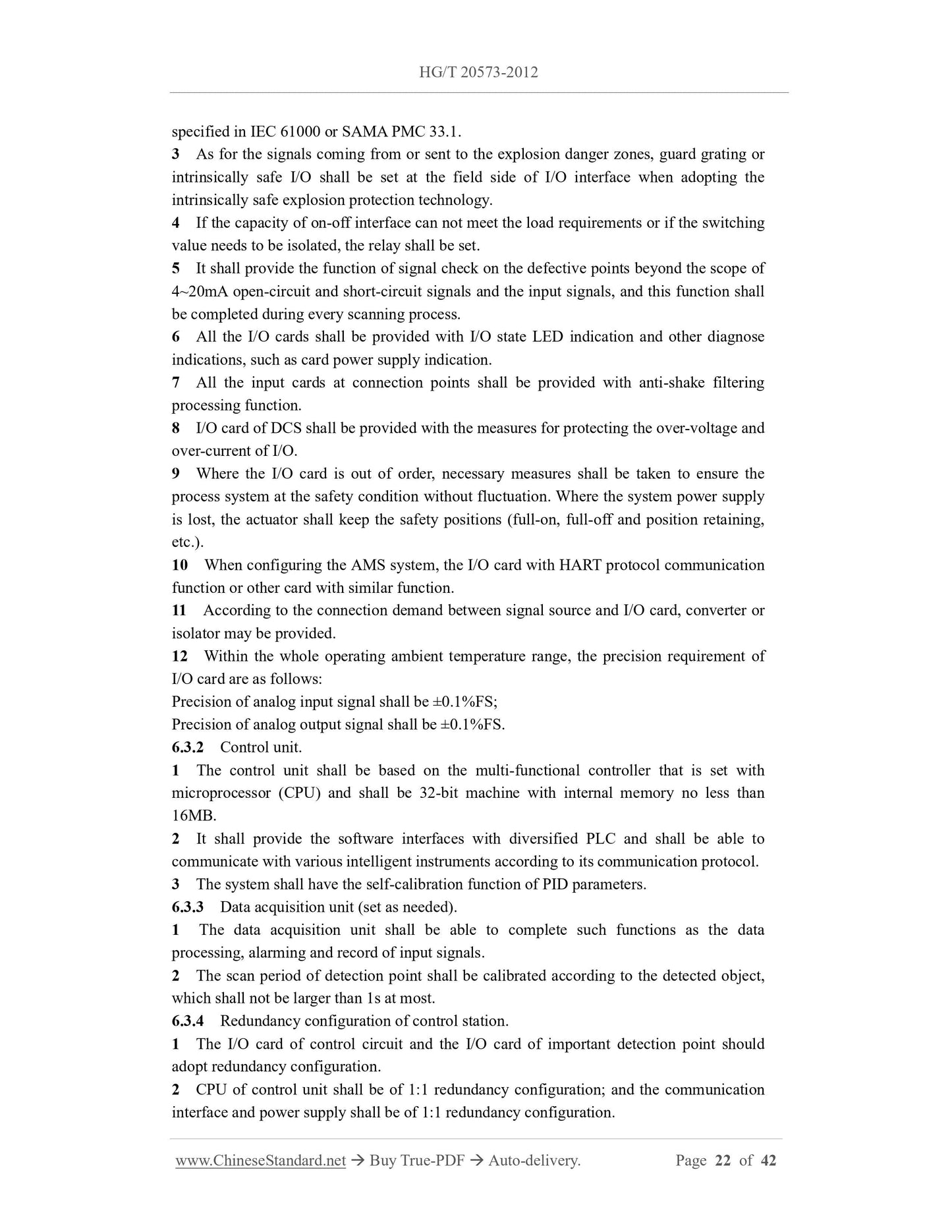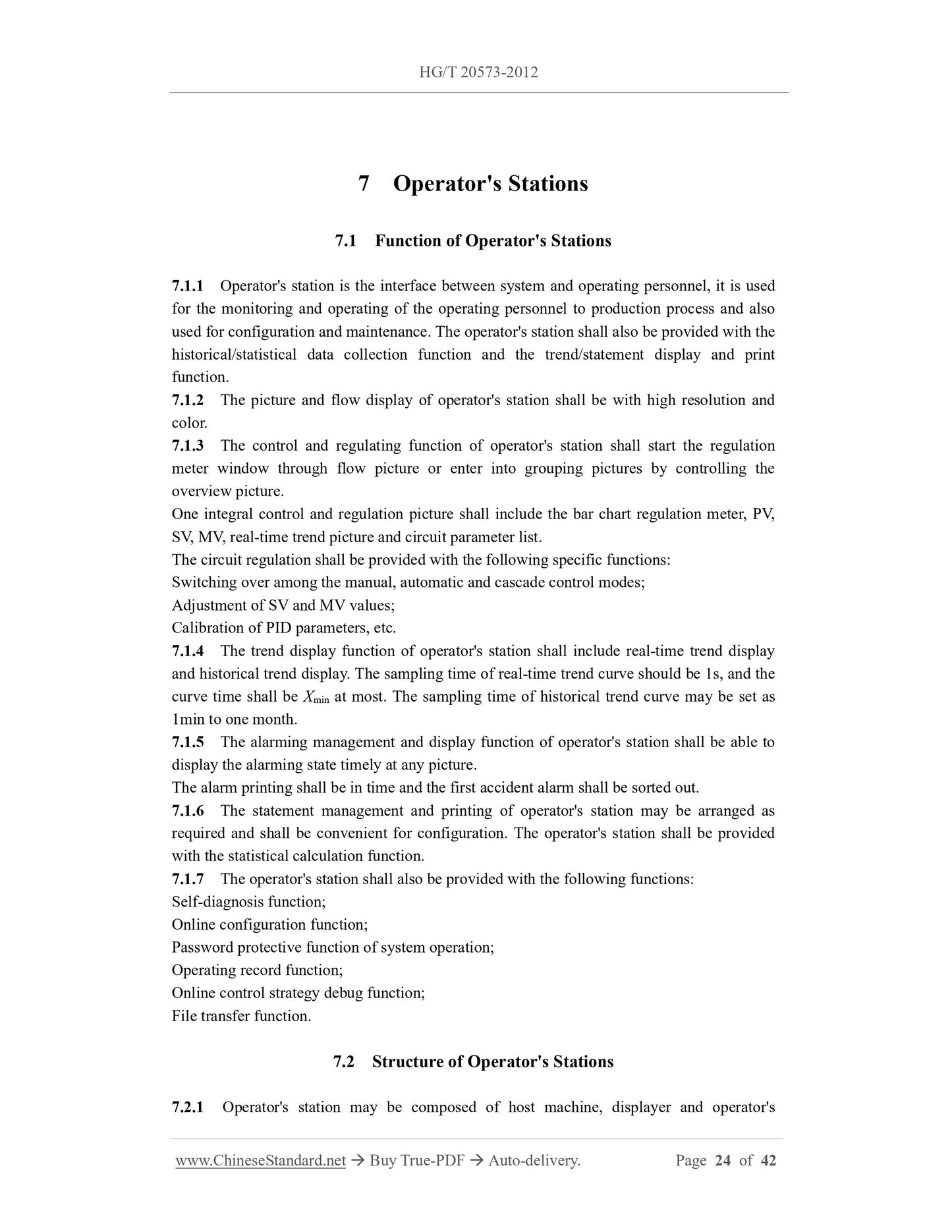1
/
of
12
PayPal, credit cards. Download editable-PDF and invoice in 1 second!
HG/T 20573-2012 English PDF (HGT20573-2012)
HG/T 20573-2012 English PDF (HGT20573-2012)
Regular price
$705.00 USD
Regular price
Sale price
$705.00 USD
Unit price
/
per
Shipping calculated at checkout.
Couldn't load pickup availability
Delivery: 3 seconds. Download true-PDF + Invoice.
Get QUOTATION in 1-minute: Click HG/T 20573-2012
Historical versions: HG/T 20573-2012
Preview True-PDF (Reload/Scroll if blank)
HG/T 20573-2012: Code for distributed control system engineering design
HG/T 20573-2012
HG
Industry Standard of the People's Republic of China
Record No.: J1433-2012
____________________________________Replacing HG/T 20573-1995
Code for Distributed Control System Engineering Design
Issued on May 24, 2012 _____ Implemented on November 1, 2012
Issued by: Ministry of Industry and Information Technology of P. R. China
Table of Contents
Foreword ... 7
1 General Provisions ... 9
2 Normative References ... 10
3 Terms, Definitions and Abbreviations ... 11
3.1 Terms and Definitions ... 11
3.2 Abbreviations ... 14
4 General Requirements for DCS ... 16
4.1 Basic Technical Requirements ... 16
4.2 Application Requirements ... 16
4.3 Hardware Configuration Requirements ... 17
5 Design Principles and Responsibility Distribution of DCS Engineering Design ... 19
5.1 Design Principles ... 19
5.2 Responsibility Distribution ... 19
6 Control Stations (Process Control Stations) ... 21
6.1 Function of Control Stations ... 21
6.2 Structure of Control Stations ... 21
6.3 Technical Requirements of Control Stations ... 21
7 Operator's Stations ... 24
7.1 Function of Operator's Stations ... 24
7.2 Structure of Operator's Stations ... 24
7.3 Technical Requirements of Operator's Stations ... 25
8 Engineer's Operating Stations ... 27
8.1 Function of Engineer's Operating Stations ... 27
8.2 Structure of Engineer's Operating Stations ... 27
8.3 Technical Requirements of Engineer's Operating Stations ... 27
9 Communication Systems ... 28
9.1 Communication Networks ... 28
9.2 Communication Systems and Clock Synchronization Systems ... 28
9.3 Communication Between DCS and Other Control Devices ... 29
9.4 Technical Requirements of Communication Networks ... 29
10 Software, Application Software, Software Configuration File and Software
Configuration ... 30
10.1 Software ... 30
10.2 Application Software ... 30
10.3 Software Configuration File ... 30
10.4 Software Configuration ... 31
11 Procedure for DCS Engineering Design ... 32
11.1 Basic Engineering Design ... 32
11.2 Detail Engineering Design ... 32
12 Design of DCS Control Rooms... 33
13 Design of DCS Power Supply System, Grounding System and Lightning
Protection System ... 34
13.1 Power Supply System of DCS ... 34
13.2 Grounding System of DCS ... 34
13.3 Lightning Protection System of DCS ... 34
14 Acceptance Test, Installation, Integration Test and Commissioning of DCS ... 35
14.1 Acceptance Test of DCS ... 35
14.2 Installation of DCS ... 36
14.3 Integration Test and Commissioning of DCS ... 36
Appendix A Requirements for Preparation of DCS Technical Specification ... 37
A.1 Overview ... 37
A.2 Responsibilities and Supply Scope of the Buyer and Seller ... 37
A.3 Requirements for Hardware Configuration and Function of DCS ... 37
A.4 Technical Requirements of DCS ... 38
A.5 Software Requirements of DCS ... 38
A.6 Design Requirements of Control Rooms ... 39
A.7 Design Requirements of Power Supply, Grounding and Lightning Protection
Systems ... 39
A.8 Terminal Cabinet and Guard Grating /Isolator Cabinet ... 39
A.9 Spare Parts and Special Tools ... 39
A.10 Documentary Data ... 40
A.11 Engineering Management ... 40
A.12 Acceptance Test ... 40
A.13 Training ... 41
A.14 Preliminary I/O List ... 41
Explanation of Wording in This Code ... 42
2 Normative References
The following referenced documents are indispensable for the application of this code. For
dated references, only the edition cited applies. For undated references, the latest edition of
the referenced document applies.
"Design Code for Control Room" (HG/T 20508)
"Design Code for Instrument Power Supply System" (HG/T 20509)
"Design Code for Instrument Grounding" (HG/T 20513)
"Procedure for Engineering Design of Instrumentation" (HG/T 20636.7)
"Common Terms and Definition for Measurement and Control System Design" (HG/T
20699) design
"Terms for Distributed Control System" (JB/T 9268-1999)
"Design Code for Instrument System Lightning Surge Protection Engineering in
Petrochemical Engineering" (SH/T 3164-2012)
3 Terms, Definitions and Abbreviations
3.1 Terms and Definitions
For the purpose of this code, the following terms and definitions apply.
3.1.1 Application software
The generic term of computer programs, processes, regulations and relevant documents
required to let DCS complete the supervision on a certain production process.
3.1.2 Availability
The ratio of the time for one device or system to correctly perform its designated function to
the total time to perform this intended function as planned, which is expressed in percent.
3.1.3 Baseband LAN
A kind of local area network that is able to encode the data and also is able to realize data
transmission without wave carrier modulation.
3.1.4 Bridge
A kind of functional unit interconnecting such two local area networks that use the same
logical link control protocol but may apply different medium access control protocols.
3.1.5 Broadband LAN
A kind of local area network that is able to encode and reuse the data and also is able to
realize data transmission by wave carrier modulation.
3.1.6 Bus network
A kind of local area network that has only one access between any two data stations and in
which the data sent by one station is usable for all other stations in the same transmission
medium.
3.1.7 Communication system
A kind of system that is composed of various communication links, protocols and functional
units and provides the effective communication among the component parts of computer
network. This system ensures the information transfer by a decided mode in a group of
interconnected stations.
3.1.8 Computer integrated process system-CIPS
The automatic control system integrating such functions as routine control, advanced control,
process optimization, production dispatching, enterprise management, operating decision.
3.1.9 Data circuit
A pair of relevant transmitting and receiving access that are provided for the two-way data
communication.
3.1.10 Data processing system
A kind of complex that is composed of device, method, program and person and is able to
complete a specific group of data processing functions.
3.1.11 Data station
A complete set of functional units that is also known as station and is composed of data
terminal equipment, data circuit-terminating equipment and its common interface.
3.1.12 Distributed control system-DCS
A kind of intelligent station network that is characterized by distributed control function,
centralized operating display and hierarchical structure. It is applied for the purpose of
controlling or controlling and managing an industrial process or factory.
3.1.13 Engineer's operating station
The intelligent station provided for the Engineer at the supervision level of distributed control
system to realize the system generation, which generally also has the functions of operator's
station.
3.1.14 Ethernet
A kind of networking technology of computer local area network, which specifies link of
physical layer, the electric signals and the contents of medium access layer protocol and
meets the technical requirements of IEEE 802.3.
The industrial Ethernet is compatible with the commercial Ethernet (IEEE 802.3) technically,
but it is better to satisfy the demand of industry site in such aspects as product material
selection, product strength, applicability and instantaneity, oper...
Get QUOTATION in 1-minute: Click HG/T 20573-2012
Historical versions: HG/T 20573-2012
Preview True-PDF (Reload/Scroll if blank)
HG/T 20573-2012: Code for distributed control system engineering design
HG/T 20573-2012
HG
Industry Standard of the People's Republic of China
Record No.: J1433-2012
____________________________________Replacing HG/T 20573-1995
Code for Distributed Control System Engineering Design
Issued on May 24, 2012 _____ Implemented on November 1, 2012
Issued by: Ministry of Industry and Information Technology of P. R. China
Table of Contents
Foreword ... 7
1 General Provisions ... 9
2 Normative References ... 10
3 Terms, Definitions and Abbreviations ... 11
3.1 Terms and Definitions ... 11
3.2 Abbreviations ... 14
4 General Requirements for DCS ... 16
4.1 Basic Technical Requirements ... 16
4.2 Application Requirements ... 16
4.3 Hardware Configuration Requirements ... 17
5 Design Principles and Responsibility Distribution of DCS Engineering Design ... 19
5.1 Design Principles ... 19
5.2 Responsibility Distribution ... 19
6 Control Stations (Process Control Stations) ... 21
6.1 Function of Control Stations ... 21
6.2 Structure of Control Stations ... 21
6.3 Technical Requirements of Control Stations ... 21
7 Operator's Stations ... 24
7.1 Function of Operator's Stations ... 24
7.2 Structure of Operator's Stations ... 24
7.3 Technical Requirements of Operator's Stations ... 25
8 Engineer's Operating Stations ... 27
8.1 Function of Engineer's Operating Stations ... 27
8.2 Structure of Engineer's Operating Stations ... 27
8.3 Technical Requirements of Engineer's Operating Stations ... 27
9 Communication Systems ... 28
9.1 Communication Networks ... 28
9.2 Communication Systems and Clock Synchronization Systems ... 28
9.3 Communication Between DCS and Other Control Devices ... 29
9.4 Technical Requirements of Communication Networks ... 29
10 Software, Application Software, Software Configuration File and Software
Configuration ... 30
10.1 Software ... 30
10.2 Application Software ... 30
10.3 Software Configuration File ... 30
10.4 Software Configuration ... 31
11 Procedure for DCS Engineering Design ... 32
11.1 Basic Engineering Design ... 32
11.2 Detail Engineering Design ... 32
12 Design of DCS Control Rooms... 33
13 Design of DCS Power Supply System, Grounding System and Lightning
Protection System ... 34
13.1 Power Supply System of DCS ... 34
13.2 Grounding System of DCS ... 34
13.3 Lightning Protection System of DCS ... 34
14 Acceptance Test, Installation, Integration Test and Commissioning of DCS ... 35
14.1 Acceptance Test of DCS ... 35
14.2 Installation of DCS ... 36
14.3 Integration Test and Commissioning of DCS ... 36
Appendix A Requirements for Preparation of DCS Technical Specification ... 37
A.1 Overview ... 37
A.2 Responsibilities and Supply Scope of the Buyer and Seller ... 37
A.3 Requirements for Hardware Configuration and Function of DCS ... 37
A.4 Technical Requirements of DCS ... 38
A.5 Software Requirements of DCS ... 38
A.6 Design Requirements of Control Rooms ... 39
A.7 Design Requirements of Power Supply, Grounding and Lightning Protection
Systems ... 39
A.8 Terminal Cabinet and Guard Grating /Isolator Cabinet ... 39
A.9 Spare Parts and Special Tools ... 39
A.10 Documentary Data ... 40
A.11 Engineering Management ... 40
A.12 Acceptance Test ... 40
A.13 Training ... 41
A.14 Preliminary I/O List ... 41
Explanation of Wording in This Code ... 42
2 Normative References
The following referenced documents are indispensable for the application of this code. For
dated references, only the edition cited applies. For undated references, the latest edition of
the referenced document applies.
"Design Code for Control Room" (HG/T 20508)
"Design Code for Instrument Power Supply System" (HG/T 20509)
"Design Code for Instrument Grounding" (HG/T 20513)
"Procedure for Engineering Design of Instrumentation" (HG/T 20636.7)
"Common Terms and Definition for Measurement and Control System Design" (HG/T
20699) design
"Terms for Distributed Control System" (JB/T 9268-1999)
"Design Code for Instrument System Lightning Surge Protection Engineering in
Petrochemical Engineering" (SH/T 3164-2012)
3 Terms, Definitions and Abbreviations
3.1 Terms and Definitions
For the purpose of this code, the following terms and definitions apply.
3.1.1 Application software
The generic term of computer programs, processes, regulations and relevant documents
required to let DCS complete the supervision on a certain production process.
3.1.2 Availability
The ratio of the time for one device or system to correctly perform its designated function to
the total time to perform this intended function as planned, which is expressed in percent.
3.1.3 Baseband LAN
A kind of local area network that is able to encode the data and also is able to realize data
transmission without wave carrier modulation.
3.1.4 Bridge
A kind of functional unit interconnecting such two local area networks that use the same
logical link control protocol but may apply different medium access control protocols.
3.1.5 Broadband LAN
A kind of local area network that is able to encode and reuse the data and also is able to
realize data transmission by wave carrier modulation.
3.1.6 Bus network
A kind of local area network that has only one access between any two data stations and in
which the data sent by one station is usable for all other stations in the same transmission
medium.
3.1.7 Communication system
A kind of system that is composed of various communication links, protocols and functional
units and provides the effective communication among the component parts of computer
network. This system ensures the information transfer by a decided mode in a group of
interconnected stations.
3.1.8 Computer integrated process system-CIPS
The automatic control system integrating such functions as routine control, advanced control,
process optimization, production dispatching, enterprise management, operating decision.
3.1.9 Data circuit
A pair of relevant transmitting and receiving access that are provided for the two-way data
communication.
3.1.10 Data processing system
A kind of complex that is composed of device, method, program and person and is able to
complete a specific group of data processing functions.
3.1.11 Data station
A complete set of functional units that is also known as station and is composed of data
terminal equipment, data circuit-terminating equipment and its common interface.
3.1.12 Distributed control system-DCS
A kind of intelligent station network that is characterized by distributed control function,
centralized operating display and hierarchical structure. It is applied for the purpose of
controlling or controlling and managing an industrial process or factory.
3.1.13 Engineer's operating station
The intelligent station provided for the Engineer at the supervision level of distributed control
system to realize the system generation, which generally also has the functions of operator's
station.
3.1.14 Ethernet
A kind of networking technology of computer local area network, which specifies link of
physical layer, the electric signals and the contents of medium access layer protocol and
meets the technical requirements of IEEE 802.3.
The industrial Ethernet is compatible with the commercial Ethernet (IEEE 802.3) technically,
but it is better to satisfy the demand of industry site in such aspects as product material
selection, product strength, applicability and instantaneity, oper...
Share
